|
Lesson
3
New Settlers Move West
|
| |
|
Hundreds of
people from the United States now began to go west. They went
across the Great Plains to Oregon. Most did not cross South
Dakota. They went through Indian hunting lands to the south. These
people planned to settle in the Far West. They brought wagons and
livestock. They drove away the wildlife. Hunting became harder for
the Indian tribes of the Great Plains. Buffalo were scarce.
Indians sometimes took oxen, mules, and horses from the migrating
settlers. They fought with the people going west. Fear and anger
grew on both sides.
|
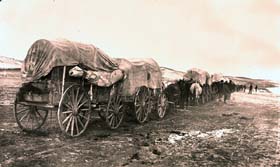
Photo courtesy of South Dakota State
Historical Society
|
|

Photo courtesy of South Dakota State
Historical Society
|
|
Eight Indian
nations met with the United States to talk about the problem. They
met at Fort Laramie in what is now Wyoming. Lakota and Cheyenne
leaders were there. These two tribes were allies. The year was
1851. The Indians said they would stop fighting with white settlers.
The Indians promised not to fight each other. They would let the
United States build roads across their lands. The United States
promised to keep whites from settling on Indian lands. It promised
to give the Indians food and tools. Neither side kept the agreement.
|
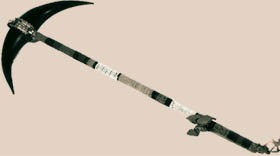
Photo courtesy of South Dakota State
Historical Society
|
|
|

Photo courtesy of South Dakota State
Historical Society
|
The
year 1854 brought new trouble. Settlers said that a Minniconjou Lakota
man had stolen a cow. Lakota warriors killed thirty soldiers when
the troops went to arrest the Lakota man. The army struck back a year later in Nebraska. General
William S. Harney led an attack on a Lakota camp. The soldiers killed
eighty-six Brulé people. Harney and his troops later marched to Fort Pierre.
|
|
|
The general and his men were not
impressed with what they saw in what is now South Dakota. They
marched through heavy rain. Their wagons and horses bogged down in
thick, gooey mud. Why would anyone want to live here, they wondered.
In summer, the land looked like a great American desert. Nor were
they impressed with Fort Pierre. The buildings at the old trading
post had fallen apart. They were not designed for an army. The men
spent a winter of misery. The next spring, General Harney moved
south. He built Fort Randall near what is now the town of
Yankton. The army was in South Dakota to stay.
|
|
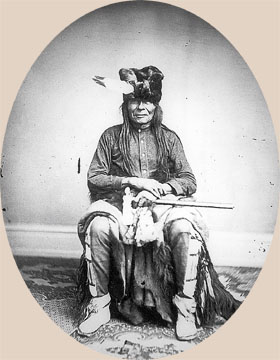
Photo courtesy of South Dakota State
Historical Society
|
One of the soldiers did like what
he saw in South Dakota. John B. S. Todd quit the army to start a
trading post near Fort Randall (learn more about Todd in Unit 5). Todd
quickly learned that he could make more money by selling land. But
first the Yankton Nakotas had to open their land to white
settlement. Yankton chief Struck-by-the-Ree went along with
Todd’s idea. Struck-by-the-Ree, Todd, and fourteen Yankton leaders went to
Washington, D. C.
There they negotiated a land treaty.
The Yanktons would live on just a portion of their lands. Only
they could settle that portion. It was to be reserved just for them.
Such land is called a reservation. The rest of the Yankton lands
were then opened to American settlers. The government agreed to pay
the tribe for the land. It would pay over one and a half million
dollars in food and supplies over fifty years.
|
|
White settlers moved into the newly
opened lands. Todd brought people to the town of Yankton. Another
land agent brought people to the town of Sioux Falls. Soon people
started the towns of Vermillion, Elk Point, and Bon Homme. The
settlers wanted the area to become a state. First it had to be a
territory. The president created Dakota Territory in 1861.
Yankton was the
capital. The
president made William Jayne of Illinois the first governor. He came
to Yankton on a steamboat. He worked in the
capitol, which
was nothing more than a log cabin. He had a
census
taken to see how many people lived in the new territory. The first
legislature met. It was known as the Pony Congress.
|
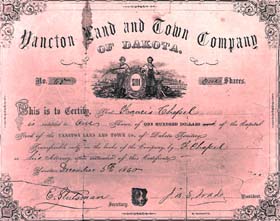
Photo courtesy of South Dakota State
Historical Society
|
|
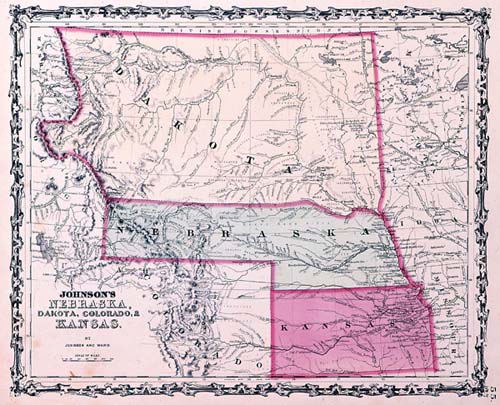
Dakota Territory Map
|
Dakota Territory grew slowly. The Civil
War started in the East. Few people ventured west. It seemed too
dangerous after a group of Santees killed five settlers. The Santees,
or Dakotas, traded much of their land to the United States for money
and supplies. They lived on a reservation in Minnesota. But white
settlers moved onto their lands without asking. Then the United
States fell behind in its payments because of the war. The Dakotas
grew hungry and
desperate.
|
Some Dakotas began to raid white
settlements in southern Minnesota and Iowa. This set off a panic in
Dakota Territory. Then two settlers were killed in a hay field near
Sioux Falls. The settlers gathered together at Yankton, where they
built a fort. Everyone left Sioux Falls. It was empty. In the end,
the raiders lost their land in Minnesota. They had to move to the
Missouri River and live with the Lakotas there.
|
|
|
| Vocabulary |
|
| capital (n.), the city or town which is the official
seat of government
capitol (n.), the building where government officials
meet to do business
|
census (n.), an official count of the people living in
a town, territory, state, or country
desperate (adj.), without hope
impressed (v.), greatly pleased
|
|
|